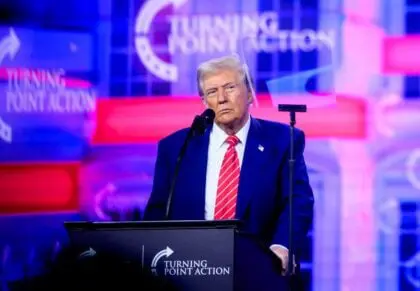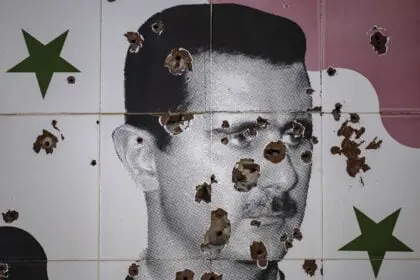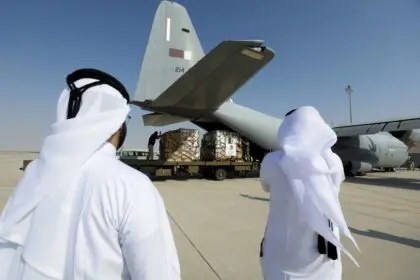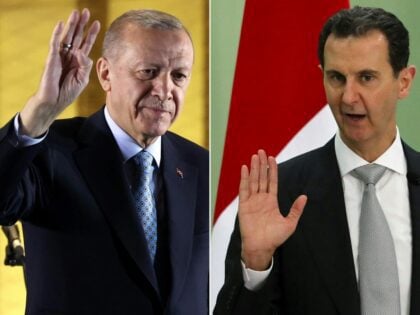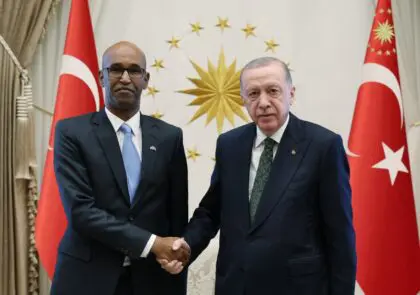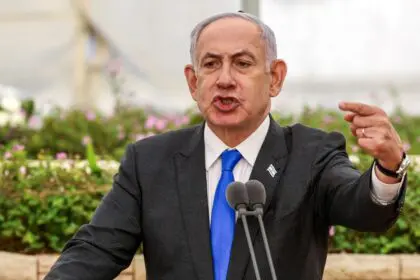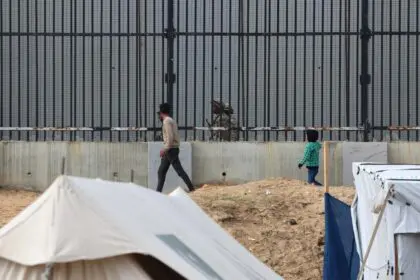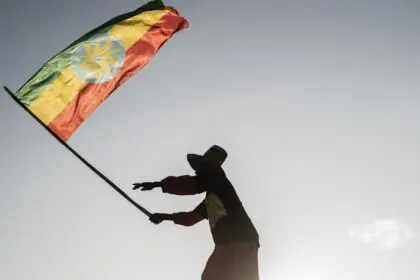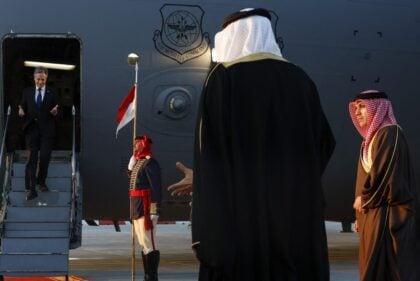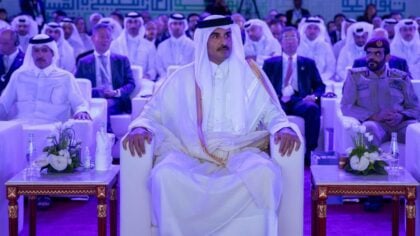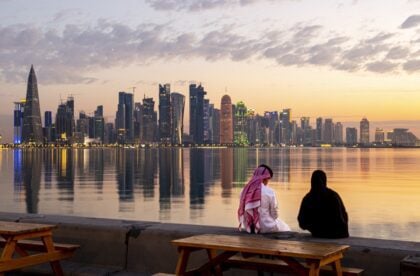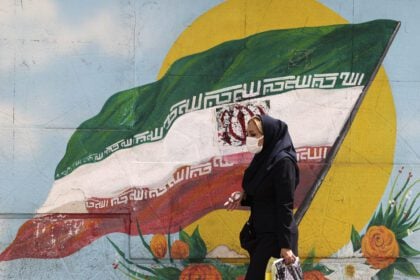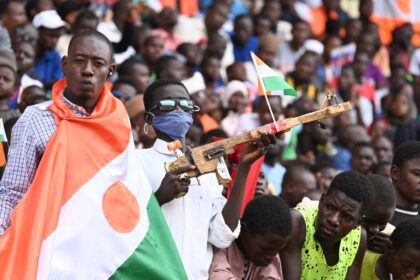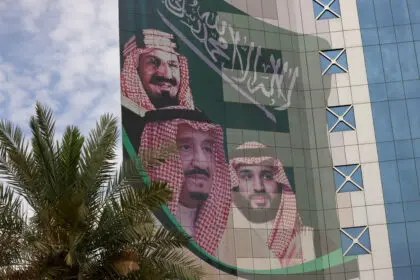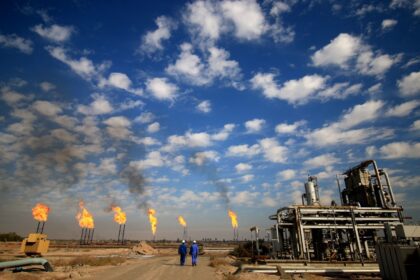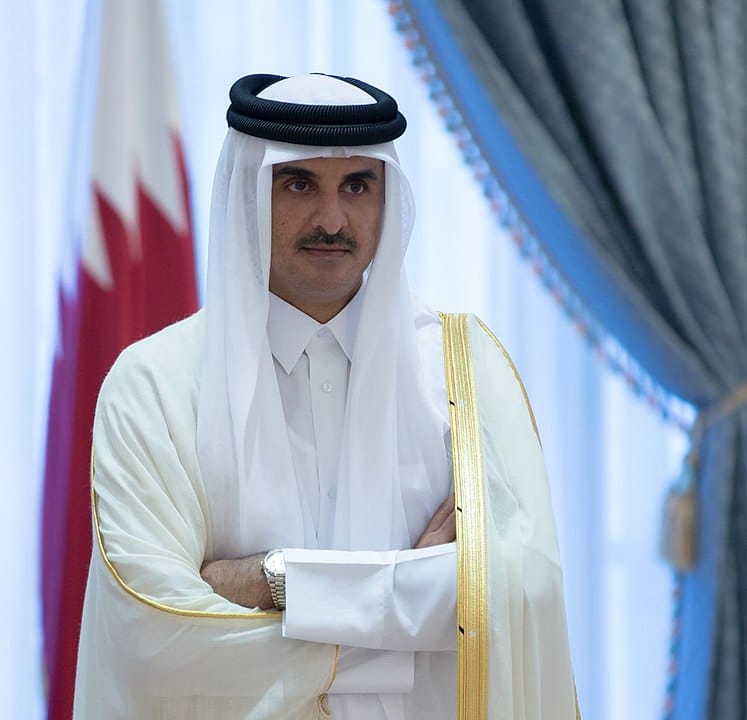
Introduction
Officially, Qatar is a constitutional monarchy.
The head of state is the Emir, Sheikh Tamim bin Hamad Al Thani, whose position is hereditary. Politically, Qatar is evolving from a traditional society into one based on more formal and democratic institutions to meet the requirements of social and economic progress.
The country’s Constitution formulates the hereditary rule of the Thani family, but also provides for an elected legislative body and makes government ministers accountable to the legislature. In current practice, the Emir’s role is influenced by continuing traditions of consultation, rule by consensus, and the citizen’s right to appeal in person to the Emir.
The Emir, while directly accountable to no one, cannot violate the Sharia (Islamic law) and, in practice, must consider the opinions of leading families and the religious establishment.
The Constitution was approved by popular vote in 2003, and came into force in June 2005. The Executive is formed by the Council of Ministers, the Legislative by the Advisory Council (currently appointed pending elections). The government is fully centralized. The Qatari Constitution is not groundbreaking in the Arab world, or in the Gulf.
Its provisions concerning the role of the state and the limited powers of the legislature are equal to those found in the constitutions of Kuwait and Bahrain. From the standpoint of civil and political rights, the Qatari charter is weak: its right of assembly is qualified, and like Kuwait and Bahrain’s constitutions, it does not permit the formation of political parties.
Many other Arab constitutions are more generous in bestowing such. Like neighbouring Gulf constitutions, the Qatari document is silent on the issue of the rights of migrant workers. The Emir appoints the cabinet, has the power to block any legislation, and can implement laws by decree. The Qatari Constitution does not address the central problems of Arab political systems, whether monarchies or republics: the lack of constraints on executive power.
The Oil Monarchy of Qatar
The Emirate of Qatar is usually referred to as an ‘oil monarchy’. This designation, which is commonly applied to all southern Gulf States, implies absolute personal rule based on the distribution of oil wealth. This definition seems exceptionally justified in the case of Qatar. The power of its ruler, Emir Tamim bin Hamad Al Thani, remains unchecked by effective constitutional control.
The Emir – Arabic for ‘one who is in charge’ – appoints the cabinet and his own advisory council, the Majlis al-Shura. The only state institution whose members are periodically elected by the citizens, the Central Municipal Council, has a merely consultative role.
Oil wealth has been an important source of political power in Qatar since the early 1950s. The ruling sheikhs have invariably used a substantial part of the oil revenues to buy off their political rivals and cement or fortify their power base. Because of this political dimension of the oil wealth, Qatar’s rulers have never been particularly inclined to make a distinction between personal and state funds.
It was only under British pressure that Sheikh Ali bin Abdullah Al Thani agreed to a formal distinction between the two in 1950. Although in 1997 the present Emir announced the drafting of legislation which would effectively separate the Treasury from the ruler’s personal funds, this law has never materialized.
However, in day-to-day business some substantial checks on the political power of the Emir do exist. Most important of all, his pre-eminent position has traditionally been challenged within the ruling family itself. Throughout the Al Thani dynasty’s existence, successions have been problematic. Already in the 1870s Jassim bin Mohammed Al Thani founded a family tradition when he ousted his father Mohammed – presenting himself as the sole ruler who was acknowledged by the ruling Ottoman empire.
When Jassim died in 1913 and was succeeded by his son Abdullah, this transfer of power was vehemently disputed by the sons of Jassim’s brother Ahmad, who was murdered under mysterious circumstances. When Abdullah abdicated in favour of his son Ali in 1949, a smooth succession could be secured only through British intervention.
Ali’s successors Ahmad and Khalifa lacked Western protection. Both were deposed by family members, in 1972 and 1995 respectively. Smooth transition of power occurred in June 2013, when Emir Hamad bin Khalifa, at the time 61, announced he would hand over power to his son Tamim.
The Royal Family
The rulers of Qatar have always had to reckon with their kin when formulating and executing policy. Among the Gulf’s ruling houses, internal Thani family strife is considered legendary. Several factors contribute to this typical feature of Qatar’s domestic political scene. One is the relative magnitude of the Thani family, which is one of the largest ruling families in the Arab world, and by far the most extensive in comparison to the national population.
According to the highest estimates, almost half of Qatar’s citizen population is somehow related to ‘the Family’. There are considered to be about 5,000 adult male Al Thanis at present. This huge family has always been divided among substantial clans and alliances, competing with each other for influence and material benefits.
It is significant that no system of primogeniture has developed in Qatar. This cannot, however, be ascribed merely to the specific nature of ‘the Family’. Probably more important is the fact that dynastic power in Qatar has only very recently been institutionalized. When Qatar became an independent country in 1971, it lacked the established pattern of authority and succession of some of the older ‘monarchies’ of the region.
In Kuwait, for example, a succession tradition was already established in the 18th century. Article 9 of the Qatari Constitution of 2005 merely states that the Emir appoints the heir apparent from among his own sons, after consulting the ruling family and ‘the people of wisdom in the State’.
Judiciary
Although the present Constitution formally provides for an independent Judiciary, the Emir still appoints all judges, based on the recommendations of the Supreme Judicial Council, for renewable three-year terms. Approximately 25 percent of these judges are foreign nationals. They are therefore dependent on residence permits granted by the civilian authorities. In 2002, the political scientist Nathan Brown wrote that judges who issued ‘unpopular’ rulings were liable to find their contracts terminated and their visas revoked. Moreover, Qatar’s judicial system was quite unique in that no form of constitutional review existed. However, the new Constitutional Court, created in 2007 alongside an Administrative Court, might theoretically shelter individuals against the all-invading power of the state apparatus.
The legal system of Qatar is based on Islamic and civil law codes. There is a discretionary system of law controlled by the Emir, although civil codes are being implemented. Islamic law dominates family and personal matters. The judicial branch includes Courts of First Instance, of Appeal, and of Cassation.
Governorates
Qatar is divided into seven municipalities or baladiyat, sometimes called governorates of provinces. These are, in order of population density: al-Dawha (or Doha), al-Rayyan, al-Khor, al-Wakra, Umm Salal, al-Daayen, and Madinat al-Shamal. The municipalities are subdivided into a total of 87 zones.
Political Representation
When the former Emir came to power in 1995, he announced an ambitious programme of political and economic reform. In this programme three major themes can be discerned: encouragement of the private sector, freedom of expression and democratization. The road the Emir chose, was clearly western-oriented.
He soon started to surround himself with other modern minded family members, offering them influential posts. His cousin, the former Prime Minister and Minister of Foreign Affairs Hamad bin Jassim – considered to be the mastermind of the reform program – is the best known member of this new pro-Western elite. Abdulrahman bin Saud Al Thani, Chief of the Emiri Diwan (the Emir’s Secretariat) and former ambassador to Washington, is another key member.
All reforms are well-publicized. To the outside world, the impression has been created that tiny Qatar blew a wind of change throughout the Gulf. As early as November 1995, five months after the bloodless coup, the Emir announced the country’s first experiment in democracy: the creation of an elected Municipal Council. General elections took place in March 1999. Adding to the sensation of a cultural revolution, Qatari women were allowed to vote and stand for office. The West cheered and applauded, but Qatar’s citizens proved less enthusiastic. Of a registered 40,000 voters only about 22,000 nationals participated in the elections.
In consecutive voting rounds the electorate did not respond massively to the government’s idea of public participation. In 2003, the year Sheikha al-Jufayri was elected as the Council’s first female member, voters’ turn-out was only 38 percent. Qatar’s population may be more motivated to drive to the voting office when the unicameral parliament, already announced by the Emir in 1999, finally materializes. In the popular referendum of 2003 they voted en masse – 93 percent – in favour of the new Constitution. According to this document, two-thirds of the Qatari parliament to be would be elected directly. The Parliament would have the power to legislate, review the state budget, monitor government policy and hold ministers accountable.
A powerful, freely elected parliament would have amounted to a cultural and political revolution – not only in Qatar but in the whole of the Middle East. But the elections, which initially were to take place in 2004, were postponed until 2005, and then until 2007. In the summer of 2013 there was still no sign of a parliament in the make.
Former Emir Hamad, before handing over power to his son Tamim, extended the term of the Shura Council to 2016, again postponing elections. Like many other promises laid down in the Constitution, which formally came into effect in 2005, there has been no follow-up on announced intentions. This could mean that the power base of the Emir is not as strong as foreign observers reckoned. It could also mean that the drive behind substantial democratic reforms has since disappeared.
Democratization
When the former Emir Hamad bin Khalifa came to power in 1995, he announced an ambitious program of political and economic reform. In this program three major themes can be discerned: encouragement of the private sector, freedom of expression, and democratization. The road the Emir chose was clearly Western oriented. He soon started to surround himself with other modern minded members of the family, giving them influential posts.
His cousin, the former Prime Minister and Minister of Foreign Affairs Hamad bin Jassim – considered to be the mastermind of the reform program – is the most well known member of this new pro-Western elite. Abdulrahman bin Saud Al Thani, head of the Emiri Diwan (the Emir’s Secretariat) and a former ambassador to Washington, is another key member.
All reforms are well publicized. To the outside world, the impression has been created that tiny Qatar has blown a wind of change throughout the Gulf. As early as November 1995, five months after the bloodless coup, the Emir announced the country’s first experiment in democracy: the creation of an elected Municipal Council. General elections took place in March 1999. Adding to the sensation of a cultural revolution, Qatari women were allowed to vote and stand for office.
Qatar’s citizens did not prove enthusiastic about these changes. Of the registered 40,000 voters only about 22,000 nationals participated in the elections. In consecutive voting rounds the electorate did not warm to the government’s ideal of public participation. In 2003, the year Sheikha al-Jufayri was elected as the Council’s first female member, voter turn-out was only 38 percent.
Qatar’s population may be more motivated to drive to the voting office when the unicameral Parliament, already announced by the Emir in 1999, finally materializes. In the popular referendum of 2003 they voted en masse – 93 percent – in favour of the new Constitution. According to this document, two-thirds of the Qatari Parliament-to-be would be elected directly. The Parliament would have the power to legislate, review the state budget, monitor government policy, and hold ministers accountable.
A powerful, freely elected Parliament would amount to a cultural and political revolution – not only in Qatar but in the whole of the Middle East. But the elections, which initially were to take place in 2004, were postponed until 2005, and then until 2007. In the summer of 2013 there was still no sign of a parliament in the making.
Former Emir Hamad, before handing over power to his son Tamim, extended the term of the Shura Council to 2016, again postponing elections. Like other promises laid down in the Constitution, which formally came into effect in 2005, there has been no follow-up on announced intentions. It could mean that the drive behind substantial democratic reforms has since disappeared.
Bureaucracy
Another important restriction on the political autonomy of the Emir is constituted by the state’s relatively extensive and complex bureaucracy. Although former Emir Hamad bin Khalifa has streamlined the state’s bureaucracy to a certain degree, it remains relatively inefficient and hard to control. This is the legacy of the way the Qatari state was originally set up.
The main priority of Qatar’s rulers was not an efficient governing state, but an efficient distributive state. Loyal family members received high state posts – sometimes ministries especially created for the occasion – as did loyal notables. The creation of government jobs for nationals was a form of social welfare. In the late 1980s, 44 percent of the citizens were employed by the state.
These numerous, unwieldy ministries and state institutions quickly developed into personal fiefdoms. The sheikhs or notables directing them created their own profitable client-patron networks, leading to widespread and extensive corruption. No independent institution of bureaucratic control exists in Qatar, and the local judges and media are extremely reluctant to take on the issue of corruption among the governing elite. Therefore the only effective control on the government is exercised by the Emir himself.
When measures are taken to counter corruption in Qatar’s public life, generally, suspects of corruption at the highest level are not brought before court, but simply sidelined.
Since the early years of the 21st century a number of government officials have been replaced. In 2005 alone the Emir removed his Chief of Staff, his Minister of Religious Endowments and his Minister of State for Council of Ministers’ Affairs, under allegations that they had personally profited from the sale of the state-owned Qatar Gas Transport Co. These measures can be seen as evidence of the present ruler’s increasing control of the bureaucracy.
The Military
Qatar is making a considerable effort to modernize sections of its military, including expanding its fighter fleet.
In 2019, 9the country ranked 106 out of 137 countries included in the annual GFP review. That year, the number of people who reached military age was estimated at 11,861 personnel, while military expenditure was estimated at $1.9 billion.In 2006, an analysis by the American think tank Center for Strategic and International Studies (CSIS) stated that the Qatari armed forces are capable of basic and low intensity missions like anti-smuggling and counter-terrorist operations. They are, however, ‘incapable of engaging any significant Iranian, Saudi, or other regional land force’.
The Qatari Army has 8,500 personnel, which is only a fraction of the size of other Gulf armies. The majority of the Qatari forces are based at the North Camp and Barzan Camp military areas.
In 2006, the armed forces’ structure consisted of a tank battalion, four mechanized infantry battalions, a Special Forces company, a field artillery regiment, a mortar battalion, an anti-tank battalion, and a Royal Guard regiment divided into three sub-units.
According to CSIS, the Air Force structure has not changed much since 1990 on the eve of the Iraqi occupation of Kuwait.
There have been small changes however, like the doubling of the number of transport aircraft to 53. The Air Force’s small air units are reported to have ‘low to moderate readiness, with reasonable to good pilot training for basic missions’.
The Air Force relies on foreign support for most ground activities.
The Qatari Navy has increased its manpower from 700 in 1990 to 1,800 in 2006, including a marine police force and coastal defence artillery. CSIS: ‘Like the other services, the Qatari Navy benefits from US basing on Qatari soil, and implicit US security guarantees.’
Gulf Cooperation Council
Apart from the military support of the US, Qatar is also part of the Gulf Cooperation Council (GCC), a defence pact that includes Qatar, Saudi Arabia, Bahrain, Kuwait, Oman and the United Arab Emirates.
GCC, established in 1981, aims to bolster the military muscle and preparedness of the rich, but mostly sparsely populated Gulf States. GCC is widely seen as a pact against military adventures by the Islamic Republic of Iran, that rose out of the Islamic Revolution of 1979. On 5 June 2017, a Saudi-led coalition of Gulf Cooperation Council (GCC) members, which included the United Arab Emirates and Bahrain, cut diplomatic ties with Qatar over its relations with Iran and alleged support for terrorism.
Military History
The Qatari armed forces have enjoyed a relatively calm history, although that has not prevented accidental skirmishes with Saudi border guards along unclearly defined borders. There was also a long-running territorial dispute with Bahrain over sovereignty of the Hawar Islands in the Persian Gulf, which was resolved in 2001.
| Index | Number | Rank out of 137 |
| Total military personnel | 12,000 | - |
| Active personnel | 12,000 | - |
| Reserve personnel | 0 | - |
| Total aircraft strength | 100 | 71 |
| Fighter aircraft | 9 | 61 |
| Attack aircraft | 15 | 61 |
| Transport aircraft | 13 | 42 |
| Total helicopter strength | 42 | 60 |
| Flight trainers | 31 | 56 |
| Combat tanks | 95 | 77 |
| Armoured fighting vehicles | 465 | 81 |
| Rocket projectors | 17 | 59 |
| Total naval assets | 80 | - |
Qatar’s military strength. Source: GFP review.
During the 1990s, patrol boats occasionally stared each other down.
In 1991, Qatari forces were employed in a Gulf Cooperation Council task force linked to the US Marines divisions that took part in the offensive to drive occupying Iraqi forces from Kuwait.
From a military perspective, Qatar is best known for the presence of large American facilities. Before 2000 only about 50 American military personnel were based in the country to guard depositories of American military supplies. After 9/11 this number increased to more than 4,000, who mostly used the Udeid Air Base. From here missions to Afghanistan were flown.
Shortly before Operation Iraqi Freedom in 2003, US Central Command established Combined Air Operations Center (CAOC) in Qatar – anticipating the reluctance of the Saudi Kingdom to grant the use of such a centre at the Prince Sultan Air Base.
In April 2016, Qatar signed a military cooperation agreement with Turkey to establish a Turkish military base in Qatar. This followed an earlier defence agreement, signed in December 2014. The venue is primarily intended for joint training exercises, with 3,000 Turkish ground troops eventually to be stationed there, alongside air and naval units, trainers and special operations forces.
According to the Stockholm International Peace Research Institute, Qatar’s weapons imports grew by 279 per cent between 2011 and 2015, when it took delivery of 24 attack helicopters, nine aerial defence systems and three early warning planes from the United States, as well as 24 fighter jets from France and 52 tanks from Germany.
Latest Articles
Below are the latest articles by acclaimed journalists and academics concerning the topic ‘Politics’ and ‘Qatar’. These articles are posted in this country file or elsewhere on our website:




